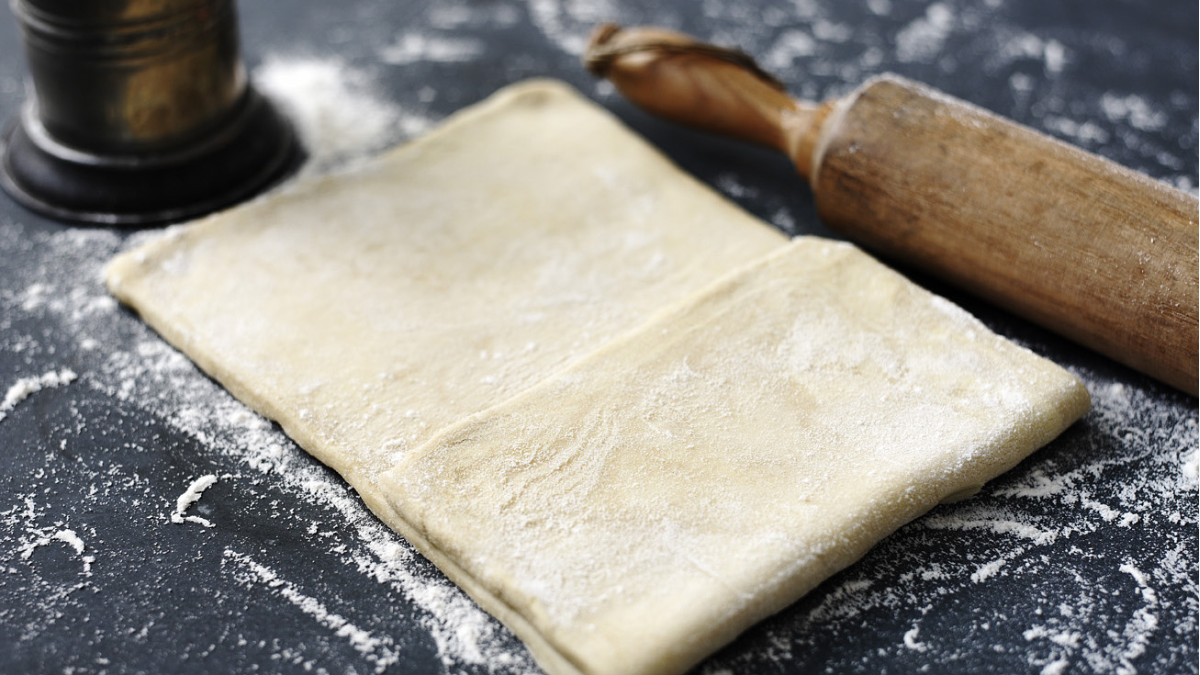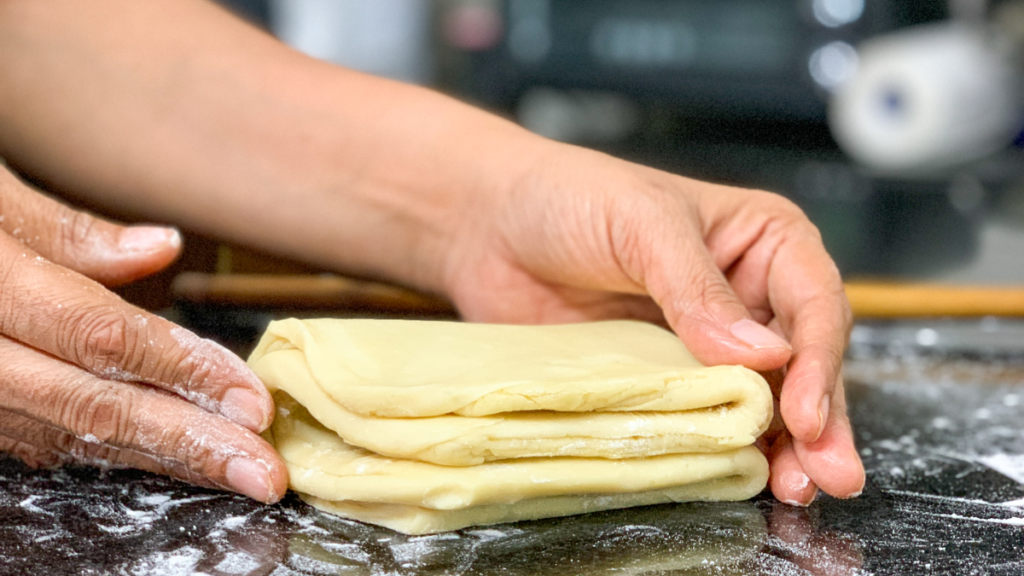This handmade puff pastry is flaky and buttery, and it’s surprisingly simple to make. You can make a high-quality, melt-in-your-mouth puff pastry in no time with only five easy ingredients. Puff pastry, also known as pâte feuilletée, is a flaky pastry prepared by layering dough together. Frozen puff pastry sheets are easy to find at the supermarket, but once you try this easy homemade puff pastry recipe, you’ll never go back to shop-bought again. Homemade puff pastry cannot be beaten, even if it does require a little elbow grease. When you create puff pastry from scratch, you can truly taste the difference in the quality of the ingredients used.
What is Puff Pastry?
Puff pastry appears to be connected to Greek and is used to make stacked pastries in a similar way. From thin sheets of dough coated with olive oil to laminated dough with layers of butter, puff pastry appears to have evolved.
The first known recipe for modern puff pastry (using butter or lard) appears in the Spanish recipe book (Book on the art of cooking) written by Domingo and published in 1607, the head cook in one of the colleges of the University of, already distinguished between filled puff pastry recipes and puff pastry tarts, and even mentions leavened preparations.
In his book published in 1611, Francisco, the head cook to Philip II of Spain (1527-1598), included various puff pastry recipes. Puff pastry is utilized extensively in this book, particularly to prepare game pies, and some Spanish commentators, such as, have even claimed credit for inventing puff pastry.
How to Make Puff Pastry Recipe?
Butter that has been chilled The butter must be cold to achieve distinct, crispy layers in your pastry. When the butter chunks melt in the oven while the pastry bakes, air pockets form, making the dough light and flaky.
Water that is ice cold. The icy cold water helps keep the dough cool and prevents the butter from melting throughout the mixing process.
It’s a good idea to make a few ice cubes ahead of time to keep your water cold. Butter should be grated, and you can freeze the butter ahead of time to make it easier to grate.
Combine the grated butter, flour, sugar, and salt in a mixing bowl. Pour the cold water over the mixture and fold it together until it forms clumps.
The butter is grated to speed up the laminating process and limit the risk of dough tearing. If you roll the dough for an extended period, the butter may become heated and melt into the dough.
I wouldn’t advocate using cubed or coarsely chopped butter instead of shredded butter. If it’s hot outside or your kitchen is humid, keep an eye on the dough.
Return the dough to the fridge to cool if it becomes too warm during the rolling process. Put it in the fridge to chill if the dough seems rubbery or begins to shrink during the laminating process.
If you’re going to freeze the dough, let it defrost in the fridge before unfolding it to avoid the frozen dough splitting or shattering.
Double wrap the dough in plastic before freezing it in a Ziploc bag to minimize freezer burn. Put your mixing bowl in the fridge ahead of time to help keep the dough refrigerated as you knead it.
Only use as much flour as you need. If you over-flour your surface, you will add more flour to the dough than is necessary. Too much flour hardens the dough and prevents the layers from adhering during the lamination process.
Gently knead the dough, roll it out into a 12-inch thick square, wrap it in plastic wrap, and chill for one hour. Begin laminating the dough by rolling it out and folding it on a lightly floured board in thirds.
Before chilling or freezing the dough, turn it 90 degrees and repeat the rolling, folding, and rotating process three more times. It should be a lot smoother than it was when you first started.
Ingredients
- 1 cup cold unsalted butter (227g)
- 2 cups flour (all-purpose) (240g)
- One teaspoon of sugar (12g)
- kosher salt (1/2 teaspoon) (2g)
- 8–10 tablespoons of cold water (120-150 mL)
Instructions
- Freeze butter for 10 minutes before using.
- Combine flour, sugar, and salt in a large mixing bowl.
- In a mixing bowl, grate the frozen butter into the flour. (If you can’t grate the leftover butter, dice it.) Toss the butter into the flour mixture with your hands until evenly distributed.
- Pour six tablespoons of water over the ingredients and fold them together until it forms clumps. Add a tablespoon of water until a loose, crumbly dough forms. (When squeezed, it should stay put.)
- Knead the dough in the bowl a few times until it forms a cohesive mass. Wrap securely in plastic wrap and shape into a 12-inch thick square. 1 hour of chilling
- Roll the cold dough into a 1/2-inch-thick rectangle on a lightly floured surface. Like a letter, fold the dough in thirds, and make a 90-degree turn. Three more times, roll, fold and rotate the dough.
- Fold back into thirds, wrap firmly, chill for at least 2 hours or up to 2 days, or freeze for up to 2 months in a freezer bag.
Is There an Egg in Puff Pastry?
Puff pastry, in reality, is traditionally made with butter, thus the buttery flavor, and is usually produced using an egg. On the other hand, many store-bought puff pastries are manufactured without dairy or egg to make them more shelf-stable. Although the egg yolk will give the completed baked dish a golden color, pastry chefs use an egg wash mostly for sheen. An egg white alone can be used to create a clear sheen. On the other hand, milk is used to promote browning.
Although eggs are included in some puff pastries, eggs are not used in the usually made dough. To extend the shelf life of manufactured puff pastries, chemicals such as calcium carbonate, reduced iron, vitamin C, and mono and diglycerides are used. Yes, eggs are present in most pastry cake, and it is used to make the cake fluffy and velvety. Different pastries are prepared with different ingredients because the flour inhibits the egg from forming. There are now egg-free pastries available for those who do not consume eggs.
Is There Milk in Puff Pastry?
Dairy is rarely found in puff pastry. However, after analyzing 25 puff pastry brands, I discovered four included butter. Rather than butter, palm oil and other vegetable oils are used as the fat source in most puff pastry brands. Puff pastries are produced using enriched wheat flour dough, filled with shortening (such as Crisco), and folded to form a Paton. Manufacturers commonly utilize dairy-based butter, while others add milk to improve the buttery richness of the end product. The vegan status of Pampas shortcrust and puff pastry sheets have been certified. Note the brand’s Butter Puff variation should be avoided.
A few goods in dairy-free baking and cooking make life so much easier. Jus Rol pastry is one among them. Jus Rol makes an oil-based pastry that is dairy-free. It is simple to produce sweet and savory pies, tarts, and even handmade sausage buns. They even have a gluten-free option, which is fantastic. Some types of pastries are dairy-free by nature. Phyllo dough, also known as filo dough, does not generally involve butter or milk; however, some recipes may call for the latter. Some recipes merely call for vegetable shortening, while others need butter.
Puff Pastry Good for you
- Puff pastries get their name because they puff out when baked. They are heavy in calories and fat, making them unsuitable for optimal health or weight loss diets. Filo pastry offers a significant health benefit because it has no fat, and it is only made of flour and water.
- Fat is brushed on the layers as they are built for recipes, in the form of melted butter, spread, or oil; thus, the amount of fat used is up to the cook. Puff pastry has a lot of fat since it needs to build all of those layers.
- Butter is a common fat; however, hard margarine, not spreadable margarine, is an excellent option. Puff pastry contains at least half as much fat as flour, but the ratio of flour to fat can be as high as one-to-one.
- Refined sugar, refined wheat flour, hydrogenated oils, unhealthy trans fats, and chemicals and artificial substances go into processed pastries. Trans fat has been linked to coronary artery disease, sudden cardiac death, and diabetes.
Is Puff Pastry the Same as Phyllo Dough?
Puff pastry and phyllo dough differ primarily in fat content and processing. Puff pastry is a laminated dough with layers of butter that give it its trademark airy puff, whereas phyllo dough is low-fat. The sole ingredients in phyllo dough are flour, water, vinegar, and a small amount of oil. It would help if you did not swap phyllo dough for puff pastry or vice versa due to the significant changes in thickness, materials, and preparation methods. They’re very different pastries with various textures, and you’ll get the greatest results if you use the right one in your recipe.
Laminated puff pastry is made by folding butter into the dough several times to create alternate layers of butter and dough. This creates a texture with many tiny layers and a light feel. On the other hand, Phyllo is a paper-thin dough made with oil rather than butter. Baklava is traditionally created using phyllo dough, and the preparation is a labor of love. Instead of using homemade puff pastry, these quick pastries use store-bought puff pastry and have all of the same excellent flavors. As soon as they come out of the oven, brush them with warm honey to give them a lovely flavor.
How can I Make Puff Pastry Without Butter?
Coconut oil turns out to be an excellent substitute for butter in a quick vegan puff pastry. Because of the fat structure and its use in the dough, it’s a terrific substitute for the customary sticks and sticks of butter.2 tbsp. Water, gradually incorporated into the dough two teaspoons milk, gently mixed in with dough; final two tablespoons water, softly mixed in with the dough. The dough should still be crumbly but stay together when squeezed together. Place the dough on a clean surface. It is achievable, and we provide a recipe for butter-free puff pastry.
You may make a delicious and healthier flaky crust for whatever you like by following the steps we’ll show you. The only difference is that the oil will substitute the butter to make a great dough that looks and tastes identical. The butter in the dough contributes to the airy, flaky quality that these pastries are known for. The butter melts and creates steam while the dough bakes, trapping it in the dough and producing air pockets. These air pockets become delicate layers of flaky dough once the dough has cooled.
Conclusion
Puff pastry is a laminated dough known for its paper-thin sheets of fluffy, soft-yet-crackly crust. It’s made by layering and folding the dough with cold butter several times, with trips to the refrigerator. Gluten develops during the rest intervals, and when the bread is baked, the water in the butter turns to steam, forcing the pliable layers apart from within and leaving a beautiful golden-brown shine on the top. Though croissants, kouign Amann and vol au vent are typically associated with French cuisine, the antecedent of modern puff pastry.

